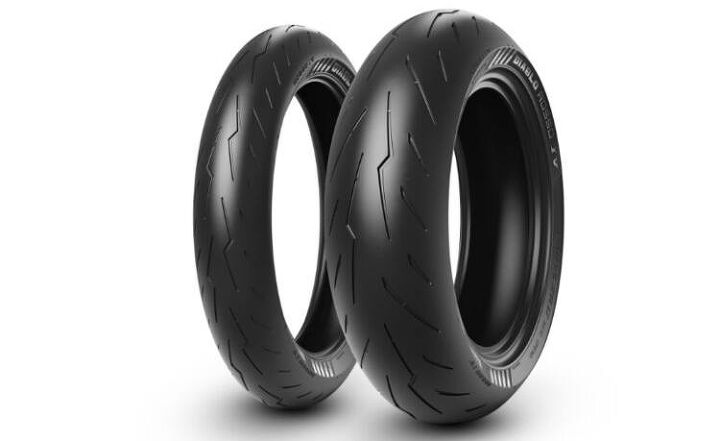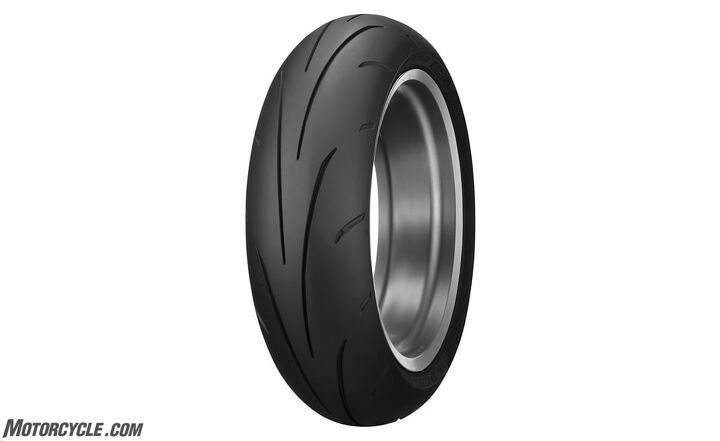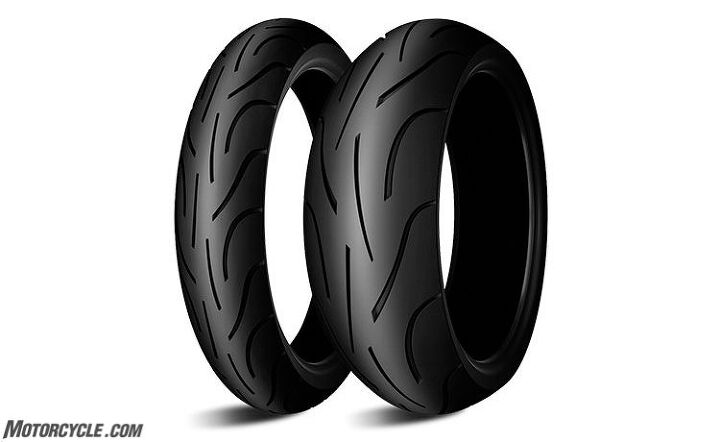The job of a sportbike tire is a tough one. Considering the performance – and variety – of today’s modern sporting machines, an ideal tire needs to be able to warm up quickly, offer good grip in both wet and dry conditions, transfer feedback to the rider, and provide good handling capabilities. Thankfully, all the major tire companies work tirelessly to improve their tires to meet these demands. Of course, longevity is a concern as well, but compared to a sport-touring tire a sportbike tire won’t quite measure up with all the other duties it has to perform.
Here, we’ve gathered seven different tires that are great at handling it all. We’ve focused on street-based tires, since that’s where the majority of sportbike riders spend their time, although all of the tires here are more than capable of handling the occasional trackday or two. If you’re the serious trackday/racing type, we’ll have a separate guide for you coming soon.
Table of Contents
Editor's Pick: Pirelli Diablo Rosso IV

Since it wears the roman numeral IV on its sidewall, you’ve likely guessed that Pirelli has developed three previous versions of the Diablo Rosso tire. This latest iteration continues the family’s supersport-inspired performance delivered in a package entirely at home on the street or the occasional trackday.
Pirelli says each size of the Diablo Rosso IV has been “developed in a bespoke way according to the characteristics and needs of each machine,” factoring in the different weights and power outputs of each bike. What separates the IV from previous versions is Pirelli’s continual refinement of the tire’s profile, based on lessons learned as the spec tire provider of the World Superbike championship. A flexible and responsive carcass help transmit feedback to the rider while also helping the tire get up to temperature quickly. Full silica compounds also ensure fast warm-up times, and Pirelli’s Cap&Base structure on the rear tire help give it stability and grip while cornering and accelerating.
Avon 3D Ultra Sport

The Avon 3D Ultra Sport tires aren’t as widely known as other brands, but offer impressive performance. The 3D in its name refers to the sipes cut into the tire with three-dimensional points underneath that interlock and limit tread flex, thus allowing for quicker warm-up times and better stability. Avon’s variable belt technology places the steel cords close together in the center for stability and even wear, while the cords are further apart at the edges to give as big a footprint as possible while leaned over. And, of course, a bigger footprint means more grip.
Triple Extrusion tread compound features more durable compound in the center of the tire for longevity and a softer compound at the shoulders for – you guessed it – better grip. A third compound underneath the two binds them together and helps with cooling.
Bridgestone Battlax Hypersport S22

If the Bridgestone Battlax Hypersport S22 sounds familiar to you, maybe it’s because our own Evans Brasfield just finished sampling them at the Jerez circuit. The latest in B-Stone’s street-focused sportbike tire lineup, the S22 takes the popular S21 and makes it better through the use of new compounds, new tread patterns, and more. With two different compounds in front and three in the rear, the S22s are able to perform over a wider range of temperatures.
In the rear, Bridgestone engineers shrunk the size of the silica molecules, providing more silica for the same surface area. This means more contact with the road (though at a granular level). Bridgestone’s ULTIMAT EYE technology, a proprietary tire dyno that allows engineers to measure contact patch grip and slippage in a controllable/repeatable manner, the designers were able to test a wide variety of compounds and profiles. Through this testing, the slippage at the back edge of both front and rear contact patches was reduced. The payoff for this effort is increased cornering grip and lessened tire wear. Needless to say, check out the review link above for even more details about this very capable tire.
Continental Sport Attack 2

Entirely made in Germany, the Continental Sport Attack 2 tires are another option worthy of consideration. Unlike other tires here which use different compounds to achieve results, Continental uses its Multigrip technology with the Sport Attack 2, which allows for a single compound to be used throughout. Temperature-controlled curing of the tire is what allows it to achieve more mileage in the center with better grip on the sides. By using a single compound there’s a smooth, continuous transition from upright to full lean.
Continental’s TractionSkin technology puts a micro-rough surface on the tire via new mold coating method which eliminates the need for release agents. The result? Virtually zero break-in time. Lastly, the zero-degree belt ensures excellent stability from the tire, especially at high speeds.
Dunlop Q3+

Dunlop made a good street/track tire with the standard Q3, but then it went and made it even better with the Q3+, redesigning 80% of the old tire. Our own John Burns reviewed the Q3+ when it was released in 2017. The big change is a new silica-enriched center tread section. Much of the credit for the Q3+’s increased longevity goes to this new compound, which will add many miles to the tire without sacrificing grip, says Dunlop. The CFT, or Carbon Fiber Technology, first seen on the Q3 returns on the +, which provides reinforcement in the sidewalls for exceptional cornering stability at high lean angles, responsive and precise steering, and predictable, smooth transitions. Changes in construction and compound contribute to increased tire stability while maintaining the current tire profile, giving the Q3+ a 3.5% to 6% bigger footprint and therefore more grip at max lean angles.
The Q3+ was designed and manufactured in Dunlop’s Buffalo, New York facilities, right alongside the company’s proven racing tires, so you know it comes from a rich pedigree. You can read John’s review linked above for all the nitty-gritty details on the Q3+ and see if it’s right for you.
A quick note: Dunlop also has a newer tire called the Q4, but we actually prefer the Q3+ better for more all-around performance.
Metzeler Sportec M7 RR

As one of the most dominant tire manufacturers at the Isle of Man TT, Metzeler knows a thing or two about making sportbike tires that perform well on the street, especially at racing speeds. With the Sportec M7 RR, you have a tire incorporating the lessons learned from the TT. Metzeler paid a lot of attention to making a tire that can perform in both wet and dry conditions, hence the amount of grooves (and their placement) compared to other tires here. Evans provides a more detailed explanation of the grooves, why they are placed where they are, and why they are important (among several more details) in his review of the M7 RR.
Performance in varying conditions is also dependent on compound, and the M7 RR uses a dual-compound rear with 100% silica on the edges for quick warmup (the front is 100% silica). A harder compound in the central portion of the rear tire not only provides longevity, but also helps with stability during side-to-side transitions.
Pirelli Diablo Rosso Corsa II

Pirelli says all the new safety technology on today’s sportbikes has allowed the average rider to ride faster and safer than ever before. But going faster typically means carrying greater lean angles. To keep up, Pirelli updated is beloved Diablo Rosso Corsa into this – the Diablo Rosso Corsa II. This is a significant tire because it’s the first Pirelli to feature multiple compounds, in as many as five different zones (for the rear) consisting of full carbon black, full silica, and a 70% silica makeup in the center (the other 30% being a combination of resins and polymers for stability and longevity). The front uses three zones of either full carbon black (edges) or full silica (center). The profile of the new tire is different, too; the more triangulated shape enhances quick transitions and maximum stick at full lean where the shoulders are broader for a bigger contact patch.
All of this is a long way of saying Pirelli has incorporated everything it has learned from being the sole tire supplier for World Superbike into a street tire – a street tire more than capable of handling track duty. It warms up fast, provides plenty of stick, and delivers great feel at the edge. It even lasts a while, too. How do we know? Because John reviewed the Diablo Rosso Corsa II at Laguna Seca in 2018. Read the review to learn more.
Michelin Pilot Power 2CT

Michelin’s Pilot Power 2CT is one of the first tires to incorporate multi-compound technology in a sportbike tire, and still remains a good choice in rubber. Michelin’s own propaganda material states the 2CT, “uses three new silica-reinforced tread compounds. Developed from MotoGP rain tires, the silica component helps provide grip and progressive responsiveness on cold, wet surfaces… The front tires integrate a soft compound, while the rear tires are made with a harder compound that can withstand greater demands during acceleration. The rear tires also have a slightly softer section, part of which is in contact with the ground even when the motorcycle is fully upright. This facilitates warmup, and, consequently, grip.”
Speaking of grip, Michelin’s test riders were able to achieve 51.2º lean angle (in the dry, of course) on the test track – an impressive feat. We reviewed the Pilot Power 2CT on, of all things, a Kawasaki ZX-11 and came away impressed.
Metzeler Sportec M9 RR

Metzeler’s Sportec M9 RR tire is built for a wide array of sportbike tasks. From commuting to the weekend canyon run, or even the odd trackday here or there, the Sportec M9 can handle it. From the outset, Metzeler designed the M9 with modern motorcycles in mind. This means electronic rider aids were given considerable thought during the design process, because if the tire can handle the bike’s power then traction control won’t have to intervene.
Both front and rear tires use a dual compound construction. The heavier carcass construction gives good durability while the softer outer section gives optimum grip – it’s a win/win. Metzeler tested the tires in both wet and dry conditions on a variety of different machines to log how each manufacturer’s electronic aids acts, then went about trying to optimize the M9 accordingly. This is no small task.
Boasting Metzeler’s first 100% silica compound tire in the supersport category, the M9 warms up fast, has great wet grip, and even withstands the rigors of heat cycling so common after track riding. Speaking of track riding, the outermost portion of the sidewalls are slick, to give the maximum amount of grip. Last but not least, Metzeler says the M9 also delivered 10% more mileage compared to the Sportec M7 RR and its performance lasts longer over the course of its natural life. All in all, the M9 is a great all-around sport tire.
FAQ
How long do sportbike tires last?
Generally speaking, sportbikes are ridden – or are meant to be ridden – on racetracks or twisting canyon roads. These are conditions requiring optimum grip. Tire manufacturers face the continual struggle of balancing between grip and longevity. If you want more of one then you have to lose a little bit of the other. Sportbike tires skew towards requiring more grip, which means the tradeoff is reduced tire life compared to, say, touring tires. Considering street riders tend to wear out the center of the tire quicker than the sides, manufacturers have developed tires with a harder center and softer side profiles to give the best of both worlds – optimum grip and longevity. Ultimately, however, it’s hard to say how long a sportbike tire will last because so much of it depends on the rider and their use case. Typically, a few thousand miles is common, depending on the tire.
What should I consider when choosing sportbike tires?
Like with any tire purchase, you should consider the conditions you’ll be using the tires in the most. This is especially important with sportbike tires, as there is a wide spectrum of tires that will fit on a sportbike. You have racing slicks on one end and sport-touring tires on the other, and everything in between. So, carefully evaluate how and where you ride your sportbike, then educate yourself on the different tires to fill that role. Sometimes a single manufacturer will have more than one tire able to meet your needs. In this case, even if the two tires may seem very similar, there’s often a single defining feature differentiating them just enough to side one way or the other.
Additional Resources
We are committed to finding, researching, and recommending the best products. We earn commissions from purchases you make using the retail links in our product reviews. Learn more about how this works.
The post Best Sportbike Tires appeared first on Motorcycle.com.
from https://ift.tt/3lOXuyi
Motorcycle.com